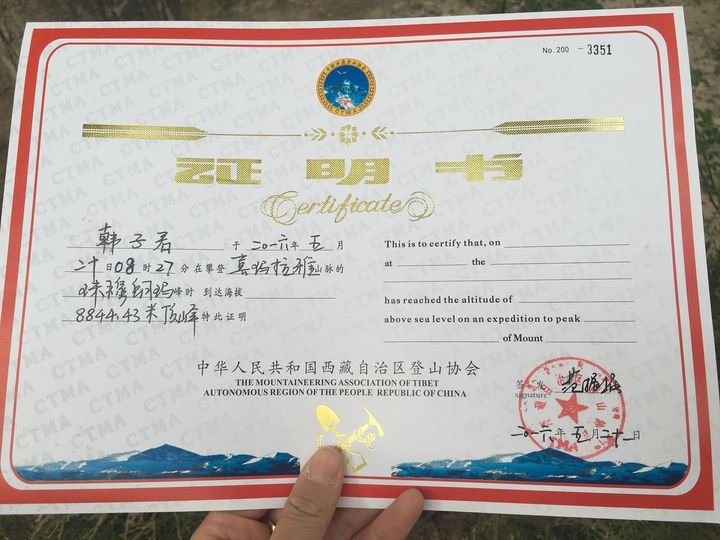A growing number of mountaineering enthusiasts are embarking on high-altitude climbs, with ascents beginning at 5,000 meters. Successful summiters need a mountaineering certificate. Beginners are frequently curious about the process for applying for mountaineering and the necessary Tibet Entry Permit. We will explore the steps required to obtain a mountaineering certificate, including how to secure the Tibet Travel Permit.
Understanding China’s Mountaineering Permit Regulations
Understanding the nuances of mountaineering permits is essential for climbers aiming to tackle high-altitude peaks within China, particularly in Tibet.
Mountaineering permits, often termed “Approval Letters,” are official documents issued by the Chinese National Sports Bureau. These permits are a compulsory requirement, as outlined by the bureau. Climbers are mandated to apply for and receive these permits well before their planned ascent. Without this authorization, high-altitude climbing activities are not legally permitted.

Mountaineering Permits: Recognition of Achievement
The peaks are above 5,000 meters in Tibet and for over 3,500 meters in other Chinese provinces, autonomous regions need a Mountaineering permit. The significance of the mountaineering permit extends beyond legal permission. It serves as a record of achievement for climbers who reach the summits and ensures their expeditions are officially recognized. Furthermore, holding a permit safeguards climbers from potential legal issues with local law enforcement, which can occur during unauthorized climbing activities.
Mountaineering Certificates: Recognition of Achievement
Furthermore, climbers planning to enter Tibet for mountaineering need to obtain a Tibet Travel Permit, also known as a Tibet Entry Permit. This is distinct from the climbing permit yet equally crucial for lawful entry into Tibet.
Overall, the permit system aims to ensure climber safety, environmental protection, and effective management of climbing activities. For those looking to scale peaks in China, especially Tibet, securing both a mountaineering permit and a Tibet Entry Permit is vital for an official and acknowledged climbing expedition.
Eligibility Requirements for Mountaineering Permit in China
Under the stipulations of China’s “Domestic Mountaineering Management Measures,” the following criteria must be met for mountaineering applications:
- Legal Entity Initiation: Mountaineering ventures must be initiated by legally recognized entities; individual climbers are not permitted to apply independently.
- Team Composition and Training: A minimum team size of two, each member must have undergone basic training in mountaineering knowledge, skills, and physical preparedness, as organized by provincial mountaineering associations.
- Professional Guidance: Teams should be led by qualified mountaineering coaches or guides, with the provision that one coach or guide may lead no more than four climbers.
- Health Clearance: Participants must complete a physical examination at a recognized second-level (or higher) hospital, certifying they are without medical conditions that would prevent their participation in mountaineering activities.
- Adequate Equipment: Teams are required to possess the necessary equipment for cold weather, communication, survival, and medical emergencies, meeting established safety guidelines.
Application for qualification requiring guidance
Under China’s “Domestic Mountaineering Management Measures,” the materials necessary for applying for mountaineering activities are
- Application form;
- Legal person qualification certificate of the initiator;
- List of team members and their mountaineering resumes;
- Qualification certificate of the mountaineering coach or mountain guide;
- Mountaineering plan;
- Equipment list;
- Additional required documents.
What are the requirements for the application process:
- Copy of the initiating entity’s business license.
- Legal representative’s ID card copy.
- Organization code certificate copy.
- Detailed climbing itinerary with leader and team member details.
- List of climbing and communication equipment.
- Insurance policy for all team members.
- Medical certificate from a qualified hospital.
- Climbing guide’s qualification proof.
- Emergency response strategy.
- Mountaineering resumes and summit certificates, if available.
Mountaineering Permit Application Guidelines
For a mountaineering permit, gather the required documents and qualifications, then apply through the Sports Bureau or Climbing Association. Follow the “Domestic Mountaineering Management Measures”:
- Apply one month in advance for announced peaks at the provincial sports department.
- For unannounced peaks, submit your application three months ahead.
- Obtain consent from respective sports departments for climbs at regional borders, with the General Administration of Sports of China resolving disputes.
- Peaks over 7,000 meters, three months before the climb needs Special approval.
- Utilize agency services for applications, especially for peaks above 7,000 meters and those not previously climbed, applying at least three months prior.
Obtaining the mountaineering pass post-summit ascent.
To reach the summit, get within 10-15m of the mountain’s highest point. Use photos, videos, physical evidence, or witnesses. Here’s how to show you’ve reached the top. Photos or videos taken at the summit are the most convincing proof. They should have a clear background that reflects the mountain’s topography, not just the sky. Including photos of the journey or camp will further enhance credibility.
Confirmation of summit achievements can come from guides, climbers, or respected certifications. Clouds and fog make markers and route descriptions important. In 1786, Balma and Packard climbed Mont Blanc without photos but confirmed it the next year. The Piolet d’Or Awards require summit photos, climbing reports, and route descriptions. Proofs like photos, maps, and descriptions establish new routes. Ueli Steck’s rope-free ascent of the Eiger in 2 hours and 47 minutes is indisputable evidence, while climbers without proof raise doubts about their use of ropes.
Mount Everest Advance Base Camp Trekking
Mount Everest is the highest mountain (8,848 meters), located on the international border between China and Nepal. It has two base camps, South Base Camp (5,364m) in Nepal and North Base Camp (5,150m) in Tibet. The north camp in particular attracts many international tourists and experienced mountaineers annually. Foreign tourists enjoy climbing Mount Everest and undertaking the Everest Base Camp (EBC) trek. Prior to doing so, they must apply for a minimum of three permits.
Essential Travel Permits for Tibet Expeditions
Obtain Your Tibet Travel Permit (TTB Permit)
For any international visitor dreaming of the majestic landscapes of Tibet, securing a Tibet Travel Permit (TTB Permit) is the first critical step. This document is a must-have and can be arranged through a recognized local travel agency within Tibet. It’s the golden ticket for those planning to explore the rich cultural heritage and breathtaking natural beauty of the region.
Frontier Pass: Your Access to the Roof of the World
Embark on a journey to the Tibetan border with the indispensable Frontier Pass. This official document, obtainable from the Armed Police Tibet Frontier Corps in Lhasa, grants you the privilege to traverse the frontier zones, including the coveted Everest Base Camp (EBC) and the route to Nepal via the Zhangmu border. The Frontier Pass is not just a formality—it’s your passport to adventure, ensuring smooth travel even when flying from Lhasa to Kathmandu.
Aliens’ Travel Permit (PSB Permit): Exploring Beyond Lhasa
To delve deeper into the restricted regions outside Lhasa’s city limits, the Aliens’ Travel Permit (PSB Permit) is non-negotiable. Whether you aim to set foot on the legendary grounds of Mt. Everest Base Camp or venture through the hidden corners of Tibet, this permit is your key to unlocking these areas. It’s conveniently available through official channels in Lhasa or Shigatse, making your travels to Everest Base Camp both possible and legal.
Mountaineering License: Ascend Beyond Everest Base Camp (EBC)
Aspiring to elevate your Tibetan adventure to new heights? Those looking to scale beyond EBC—whether it’s the Advanced Base Camp (ABC) at 6,500 meters or the mesmerizing Rongpuk Glacier—must acquire a Mountaineering License. This essential document, issued by the Tibet Mountaineering Association, is your license to climb. It also mandates the hiring of a professional climbing coordinator to guide your ascent.
As a dedicated local Tibet travel agency, we specialize in facilitating the acquisition of all necessary permits, including the Tibet Entry Permit, for your journey. Our comprehensive service simplifies the application process: just provide us with your personal details, passport, and Chinese visa, and we’ll take care of the rest. Planning an Everest Base Camp tour? Get in touch with us for a tailor-made travel itinerary that brings your Himalayan dreams to life.
Check the Official Website for Permit










